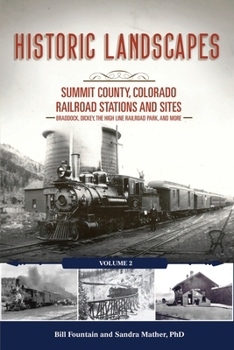Historic Landscapes: Summit County, Colorado Railroad Stations and Sites, Braddock, Dickey, the High Line Railroad, and More
Why Historic Landscapes, Railroad Stations of Summit County, Colorado? Bill Fountain first considered writing a book about the railroad stops of Summit County several years ago but he soon realized he would need two volumes to tell all the stories. Volume 2 follows the growth and demise of 17 railroad stops lining the tracks from Washington Spur, located in the saddle between Barney Ford Hill and Mount Baldy, to Dickey Station, now covered by Lake Dillon. Many of the photographs, gathered from a wide variety of sources, have not appeared in previous publications. They tell a story that hasn't been told before.
Using information taken from first-hand accounts, Denver, South Park & Pacific files, government and other archives, and newspaper articles, Fountain intertwines the effects the railroad had on the county's economy and residents with the struggles of the railroad to remain profitable. Marvel at the 158-foot-long, 10-span, wooden Gold Pan trestle that bridged Illinois Gulch south of Breckenridge. Imagine what it was like laying the 11 miles of track between Boreas Pass and Breckenridge that included 108 curves. Learn why Hookeye Curve, a nearly 360-degree curve, earned the nickname "Whiplash." Follow the story of the Gold Pan Shops, one of the most complete and
modern machine shops in the country, which made steel pipes for hydraulic mining. The company owned 1,700 acres of claims lining the Blue River and stretching into Indiana Gulch. Smile at the energy displayed by one of the most ambitious entrepreneurs in Summit County, Broncho Dave Braddock, as he built a town, harvested his vegetable gardens, produced temperance beer, and established a stage line, all before suffering a tragic death. Discover how the profits from a Summit County mine helped women suffragettes in Great Britain. A special section will introduce you to the High Line Railroad Park on Boreas Pass Road, where visitors will see some of the equipment the railroad used to fight against harsh Summit
County winters and one of the steam engines that carried freight and passengers across Boreas Pass into Breckenridge and beyond.
As in all his other manuscripts, Foutain imagined what life would have been like in the late 1800s after the arrival of the railroad and the consequences of the abandonment of the lines in 1937. He hopes you, the reader, with the help of text and photographs, will do the same.





